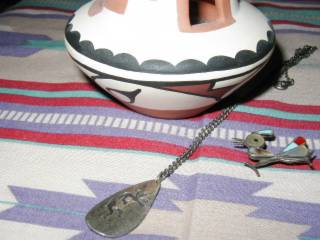Tuesday, October 05, 2004
SEASONAL CHANGES IN MY BLOG
Some of you might have noticed that I changed my blog template again : ) a few days ago. Yes, I picked the pattern of ginkgo leaves for the 1st half of October. For those who might be wondering, this is the rule of thumb here: The blog template changes once or twice a month, and the design should reflect the seasonal changes in Japan. This is the fun part of blog-keeping … at least to me. I spend hours and hours trying different combinations of the free web materials, and I just love doing it. It feels so good to have my semi-original (because I didn’t make the graphics myself) blog with a bit of --- what do you call --- cultural taste?
I had no interest in traditional Japanese designs until I went to Arizona. Then about 12 years ago, I had a chance to stay in Phoenix for 2 months. When I was there, I saw Native American traditional designs wherever I went, and I got fascinated with them.

Souvenirs from Phoenix. A clay pot, roadrunner brooch and Kokopelli pendant. Kokopelli is a flute player in Native American legend. My favorite.
The designs were unique, cute, and I somehow felt familiar with them. I wondered why, and assumed it was their close relationship with the nature that made me feel that way. Native American legends and myths reminded me of the ones we had in Japan, and their traditional designs inspired me to take another look on our traditional designs. Since then, I’ve been learning, only little by little, about Japanese traditional designs and colors. I still don't know anything more than just some names of the patterns, but when I read “The Tale of Genji,” the description of the costumes of that time makes a little more sense to me now.
I guess the Yosakoi festival we have here in this prefecture also contributes to my love of our traditional designs. For the festival, costume designers often use traditional kimono patterns arranged in modern ways, and they look so beautiful. I just love this fusion of the old and the new, like I had written somewhere before. Here in this blog, I’m trying the combination of Japanese designs and Western language, and so far, very happy with the results : )
I had no interest in traditional Japanese designs until I went to Arizona. Then about 12 years ago, I had a chance to stay in Phoenix for 2 months. When I was there, I saw Native American traditional designs wherever I went, and I got fascinated with them.

Souvenirs from Phoenix. A clay pot, roadrunner brooch and Kokopelli pendant. Kokopelli is a flute player in Native American legend. My favorite.
The designs were unique, cute, and I somehow felt familiar with them. I wondered why, and assumed it was their close relationship with the nature that made me feel that way. Native American legends and myths reminded me of the ones we had in Japan, and their traditional designs inspired me to take another look on our traditional designs. Since then, I’ve been learning, only little by little, about Japanese traditional designs and colors. I still don't know anything more than just some names of the patterns, but when I read “The Tale of Genji,” the description of the costumes of that time makes a little more sense to me now.
I guess the Yosakoi festival we have here in this prefecture also contributes to my love of our traditional designs. For the festival, costume designers often use traditional kimono patterns arranged in modern ways, and they look so beautiful. I just love this fusion of the old and the new, like I had written somewhere before. Here in this blog, I’m trying the combination of Japanese designs and Western language, and so far, very happy with the results : )
posted by obachan, 10/05/2004 10:10:00 AM
2 Comments:
commented by  GullWings, 10/06/2004 2:25 AM
GullWings, 10/06/2004 2:25 AM
 GullWings, 10/06/2004 2:25 AM
GullWings, 10/06/2004 2:25 AM
Hi Michael,
Wow, it’s very nice of you to give me this much compliment. The 4 characters you picked look more like Chinese to me. I can, to some extent, imagine what each character means, and whatever they might mean altogether in Chinese, I know you meant well. Thanks! :)
Wow, it’s very nice of you to give me this much compliment. The 4 characters you picked look more like Chinese to me. I can, to some extent, imagine what each character means, and whatever they might mean altogether in Chinese, I know you meant well. Thanks! :)



I stumbled more or less accidentally into your blog and ... I was impressed!
I like what you write, I like how you write, I like the design and I like the photos.
Nice work!
Sayonara,
我爱辛镜,
Michael
P.S.: I hope I picked the right japanese signs and there no insulting hidden in them. ;-)